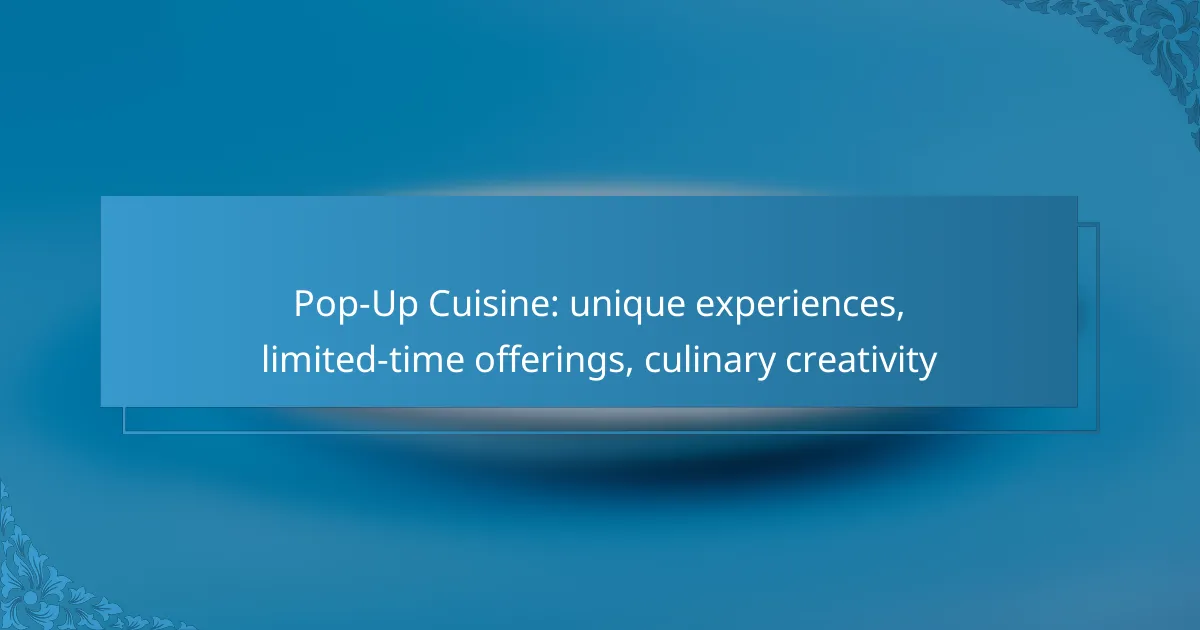Pop-up cuisine presents a thrilling opportunity for food enthusiasts to indulge in unique culinary experiences that are available for a limited time. These temporary dining events showcase innovative dishes crafted by talented chefs, allowing them to experiment and push the boundaries of traditional cuisine. From exclusive chef’s tables to vibrant street food festivals, pop-up restaurants create a dynamic food culture that invites adventurous diners to explore new flavors and trends.
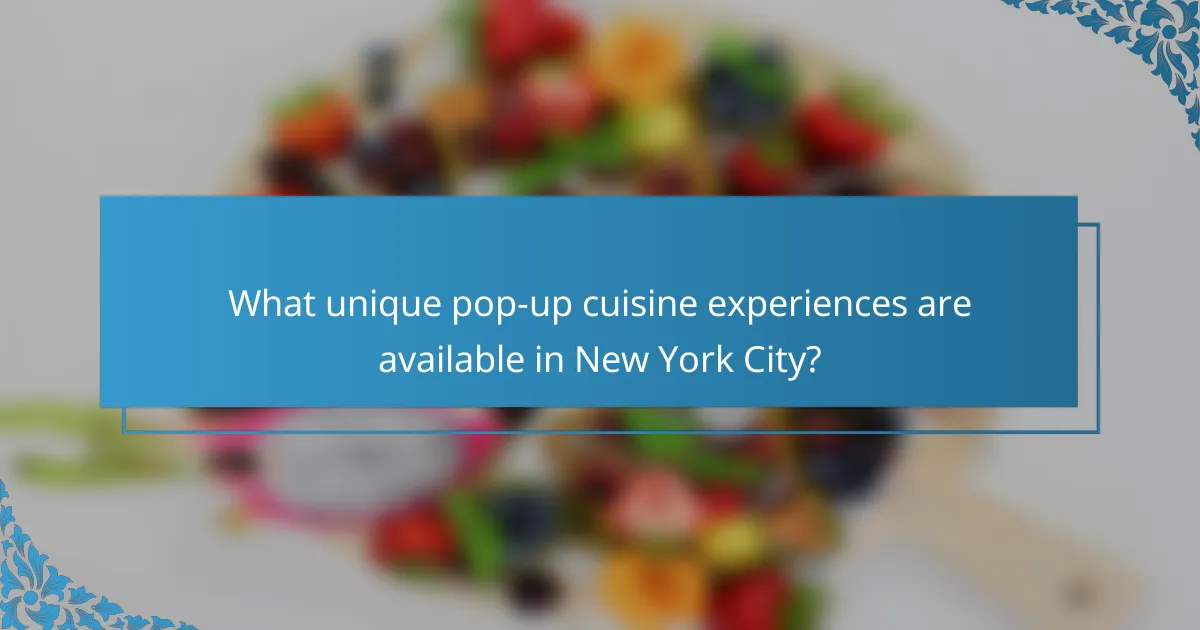
What unique pop-up cuisine experiences are available in New York City?
New York City offers a vibrant array of unique pop-up cuisine experiences that highlight culinary creativity and limited-time offerings. From seasonal rooftop dining to exclusive chef’s tables and lively street food festivals, these events provide unforgettable gastronomic adventures.
Seasonal rooftop dining at The Greens
The Greens is a popular seasonal pop-up that transforms rooftop spaces into lush dining experiences, typically available from spring through fall. Guests can enjoy a curated menu featuring fresh, locally sourced ingredients while taking in stunning views of the city skyline.
Reservations are highly recommended, as seating is limited and often fills up quickly. Expect to pay around $100 per person for a multi-course meal, which includes a drink package. Dress appropriately for the weather, as dining is outdoors.
Chef’s Table at The NoMad
The NoMad offers an exclusive Chef’s Table experience that allows diners to enjoy a personalized tasting menu crafted by the head chef. This intimate setting typically accommodates a small group and provides a unique opportunity to interact with the culinary team.
Reservations are essential and can be made several weeks in advance. The cost for this experience usually ranges from $150 to $300 per person, depending on the menu and wine pairings. Be prepared for a multi-hour dining experience that showcases innovative dishes.
Street food festivals in Brooklyn
Brooklyn hosts various street food festivals throughout the year, celebrating diverse culinary traditions and local vendors. These festivals often feature food trucks and stalls offering everything from gourmet tacos to artisanal desserts.
Entry fees are typically low or free, with food prices ranging from $5 to $15 per item. Keep an eye on local event calendars for dates and locations, as these festivals can attract large crowds. Arrive early to avoid long lines and ensure you sample the best offerings.

How do pop-up restaurants enhance culinary creativity?
Pop-up restaurants enhance culinary creativity by providing chefs with a platform to experiment with innovative dishes and concepts without the constraints of a permanent establishment. These temporary venues allow for unique, limited-time offerings that can attract adventurous diners and foster a dynamic food culture.
Experimental menus by renowned chefs
Renowned chefs often use pop-up restaurants to showcase experimental menus that push culinary boundaries. These menus typically feature unconventional ingredients or techniques, allowing chefs to test new ideas and receive immediate feedback from diners. For instance, a chef might create a tasting menu that highlights seasonal produce in unexpected ways, such as using vegetables in desserts.
By operating in a pop-up format, chefs can quickly adapt their offerings based on customer reactions and trends, creating a more responsive dining experience. This flexibility encourages culinary innovation and can lead to the development of signature dishes that may later be incorporated into their main restaurant menus.
Collaboration with local food artisans
Pop-up restaurants frequently collaborate with local food artisans, which enhances the culinary experience by incorporating regional flavors and ingredients. These partnerships can include sourcing fresh produce from nearby farms, using artisanal cheeses, or featuring local brews. Such collaborations not only support the local economy but also create a unique dining experience that reflects the community’s culinary identity.
For example, a pop-up might partner with a local baker to create a special bread for their menu, or work with a nearby brewery to offer exclusive beer pairings. This synergy between chefs and artisans results in a richer, more diverse menu that highlights the best of local cuisine, attracting food enthusiasts eager to explore new tastes.
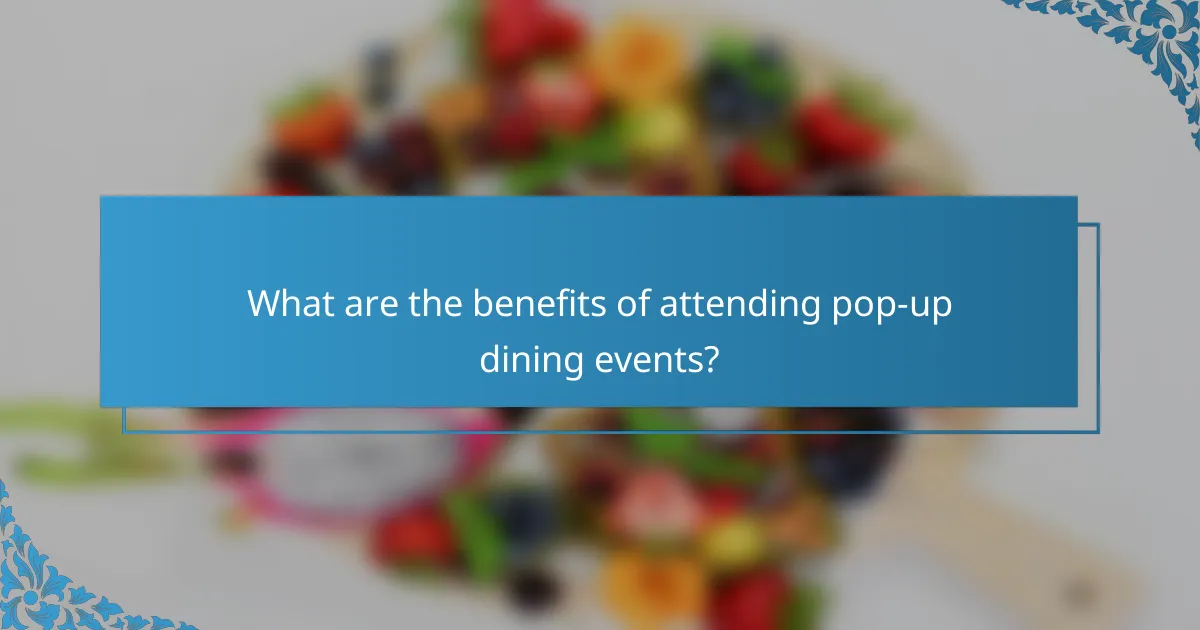
What are the benefits of attending pop-up dining events?
Attending pop-up dining events offers unique culinary experiences and the chance to enjoy exclusive dishes that are available for a limited time. These events foster creativity among chefs and provide diners with opportunities to explore new flavors and trends in the food scene.
Exclusive access to limited-time dishes
Pop-up dining events often feature specially crafted menus that are available only during the event’s run. This exclusivity allows diners to taste unique dishes that may not appear on traditional restaurant menus. For instance, a pop-up might showcase seasonal ingredients or innovative cooking techniques that highlight the chef’s creativity.
To make the most of these experiences, consider planning ahead and reserving your spot early, as popular pop-ups can sell out quickly. Keep an eye on social media and local food blogs for announcements about upcoming events, as they often generate buzz and excitement.
Opportunity to discover new culinary trends
Pop-up dining events serve as a testing ground for emerging culinary trends, allowing chefs to experiment with new concepts and flavors. Attendees can experience avant-garde dishes that reflect current food movements, such as plant-based cuisine or fusion flavors. This exposure can inspire home cooks and food enthusiasts to try new ingredients or cooking styles.
When attending these events, be open to trying unfamiliar dishes and flavors. Engaging with chefs and other diners can enhance your experience and provide insights into the latest trends in the culinary world. Additionally, consider sharing your experiences on social media to contribute to the conversation around these innovative dining experiences.
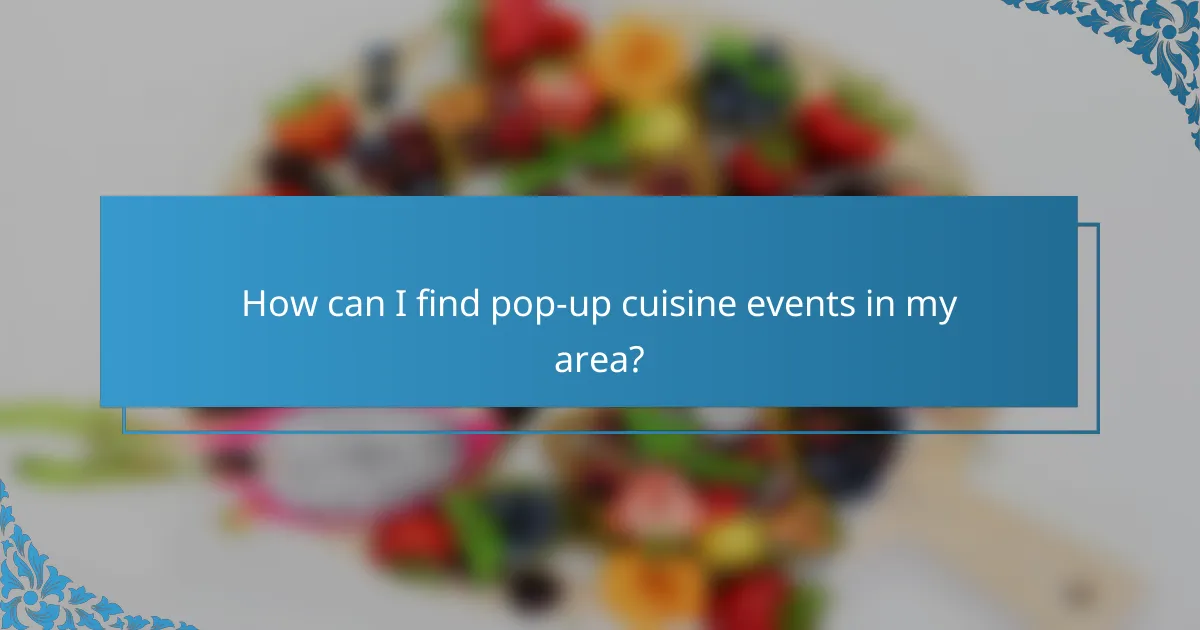
How can I find pop-up cuisine events in my area?
To find pop-up cuisine events near you, start by exploring local food blogs, social media channels, and event platforms. These resources often provide timely updates on unique culinary experiences and limited-time offerings that showcase creativity from local chefs.
Follow local food blogs and social media
Local food blogs and social media accounts are excellent sources for discovering pop-up cuisine events. Many food enthusiasts and bloggers regularly post about upcoming events, reviews, and exclusive offers. Following these accounts can keep you informed about the latest culinary trends in your area.
Look for hashtags related to your city or region, such as #YourCityEats or #PopUpDining, to find relevant posts. Engaging with these communities can also lead to insider tips on hidden gems and unique dining experiences.
Use event platforms like Eventbrite
Event platforms like Eventbrite are valuable tools for locating pop-up cuisine events. You can search by location, date, and type of cuisine to find events that suit your preferences. Many organizers list their pop-up events on these platforms, making it easier to purchase tickets and secure your spot.
Consider setting up alerts for specific keywords related to pop-up dining in your area. This way, you’ll receive notifications when new events are posted, ensuring you don’t miss out on limited-time culinary experiences.
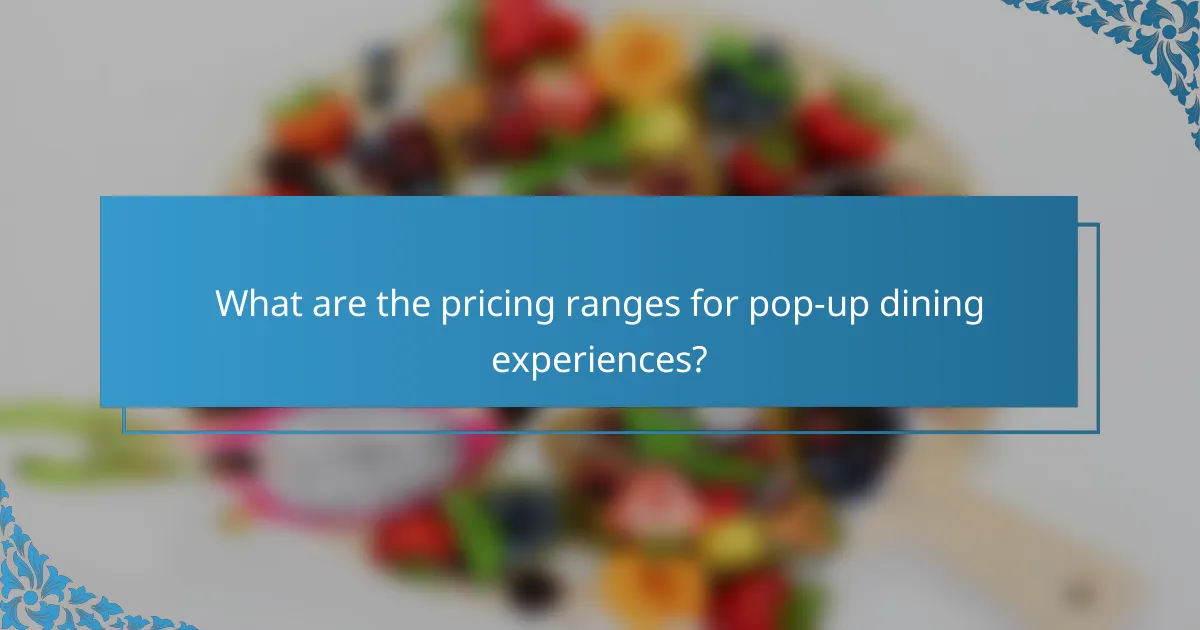
What are the pricing ranges for pop-up dining experiences?
Pop-up dining experiences typically range from moderate to high prices, depending on various factors such as location, chef reputation, and the exclusivity of the event. Generally, guests can expect to pay anywhere from $50 to $300 per person for these unique culinary offerings.
Average cost per person in major cities
In major cities like New York, Los Angeles, and London, the average cost for a pop-up dining experience often falls between $100 and $250 per person. High-end pop-ups featuring renowned chefs may charge upwards of $300, while more casual events can start around $50.
For example, a pop-up in New York City might offer a multi-course meal for around $150, while a similar experience in a smaller city could be available for about $75. The urban setting significantly influences pricing due to higher operational costs and demand.
Price variations based on location and chef
Pricing for pop-up dining can vary widely based on the chef’s reputation and the location of the event. Established chefs with a strong following often command higher prices, reflecting their culinary expertise and the exclusivity of their offerings.
Additionally, pop-ups in tourist-heavy areas or affluent neighborhoods may charge more due to increased demand and higher rent costs. Conversely, events in less populated regions may provide more affordable options, appealing to a broader audience.
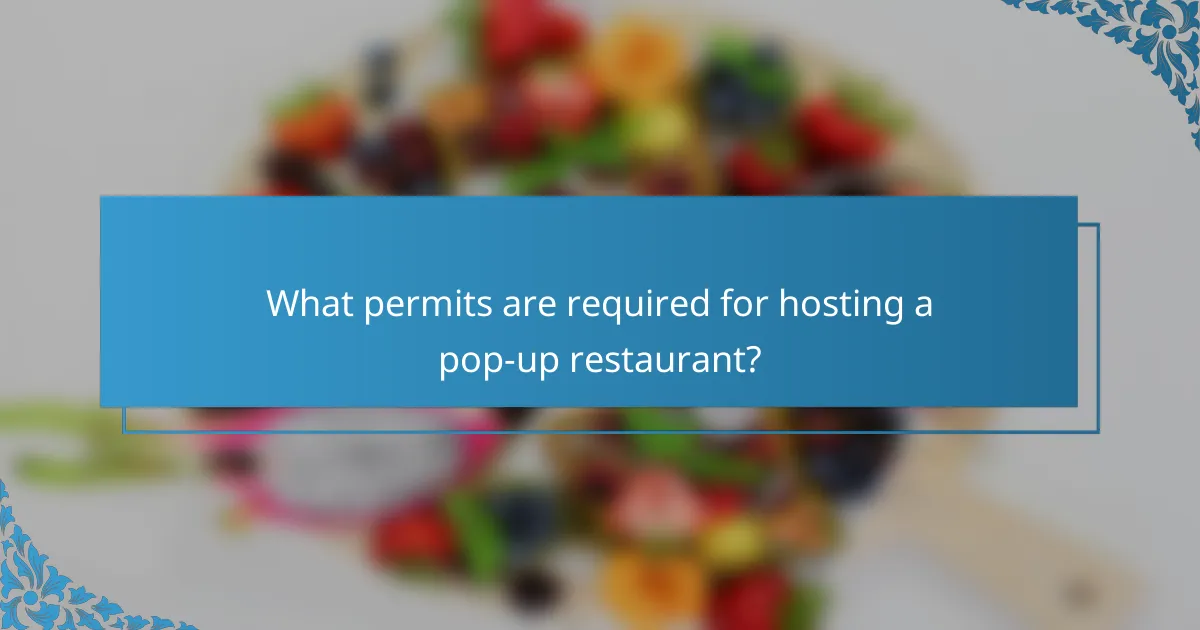
What permits are required for hosting a pop-up restaurant?
Hosting a pop-up restaurant typically requires obtaining specific permits to ensure compliance with local health and safety regulations. These permits can vary by location but generally include health department permits and temporary food service licenses.
Health department permits
Health department permits are essential for any food service operation, including pop-up restaurants. These permits ensure that the food being served meets safety and sanitation standards set by local health authorities.
To obtain a health department permit, you may need to submit an application detailing your menu, food preparation methods, and the location of your pop-up. Inspections may also be required before approval, so plan for potential delays in the process.
Temporary food service licenses
A temporary food service license allows you to operate your pop-up restaurant for a limited time, usually ranging from a few days to several weeks. This license is crucial for legal compliance and is often required for events like festivals or markets.
When applying for a temporary food service license, you will typically need to provide information about your food handling practices, the venue, and any equipment you plan to use. Be aware that fees and requirements can vary significantly by jurisdiction, so check with local authorities for specific guidelines.
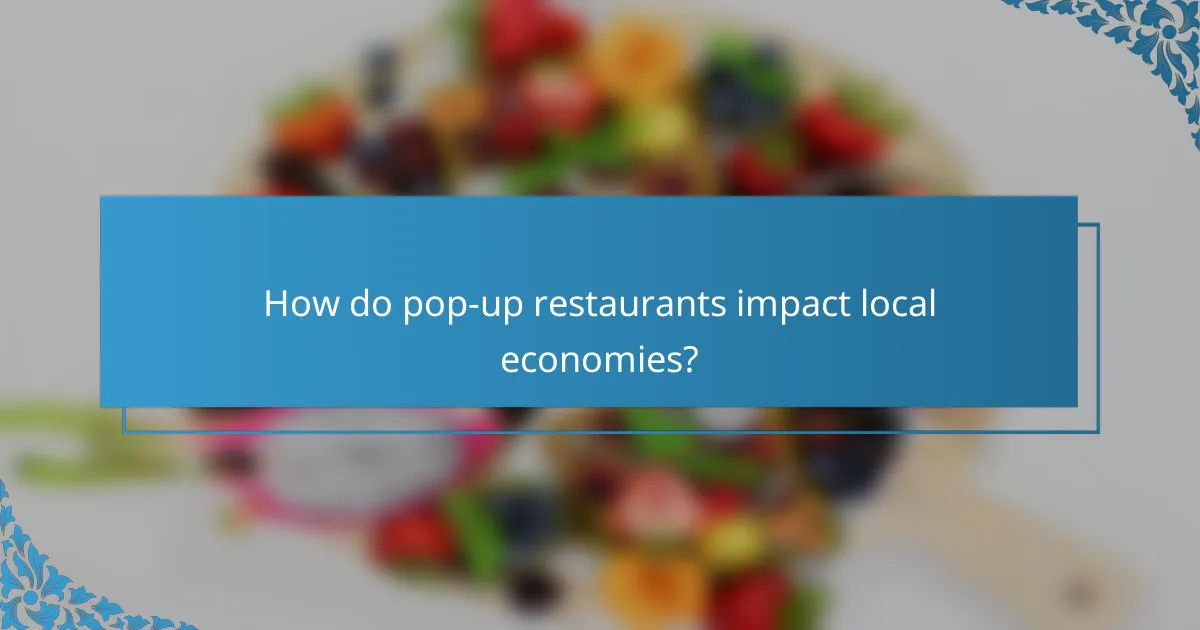
How do pop-up restaurants impact local economies?
Pop-up restaurants significantly influence local economies by creating temporary dining experiences that attract visitors and stimulate spending. These establishments often generate excitement and engagement within communities, leading to increased foot traffic and economic activity.
Boosting local tourism
Pop-up restaurants can serve as a unique attraction for tourists, drawing food enthusiasts eager to experience innovative culinary offerings. By hosting special events or themed dining experiences, these temporary venues can enhance a city’s appeal, leading to higher visitor numbers and longer stays.
For instance, a pop-up restaurant featuring local cuisine or celebrity chefs can create buzz on social media, encouraging food lovers to travel specifically for the experience. This influx of tourists can benefit nearby hotels, shops, and attractions, creating a ripple effect throughout the local economy.
Supporting local suppliers and vendors
Pop-up restaurants often prioritize sourcing ingredients from local farmers and suppliers, which strengthens community ties and supports the regional economy. By purchasing fresh produce, meats, and other goods locally, these establishments help ensure that money circulates within the community.
Additionally, collaborating with local vendors can lead to mutually beneficial partnerships. For example, a pop-up might feature a local brewery’s craft beers, creating a unique dining experience while promoting the brewery’s brand. This not only enhances the restaurant’s offerings but also boosts the visibility of local businesses.
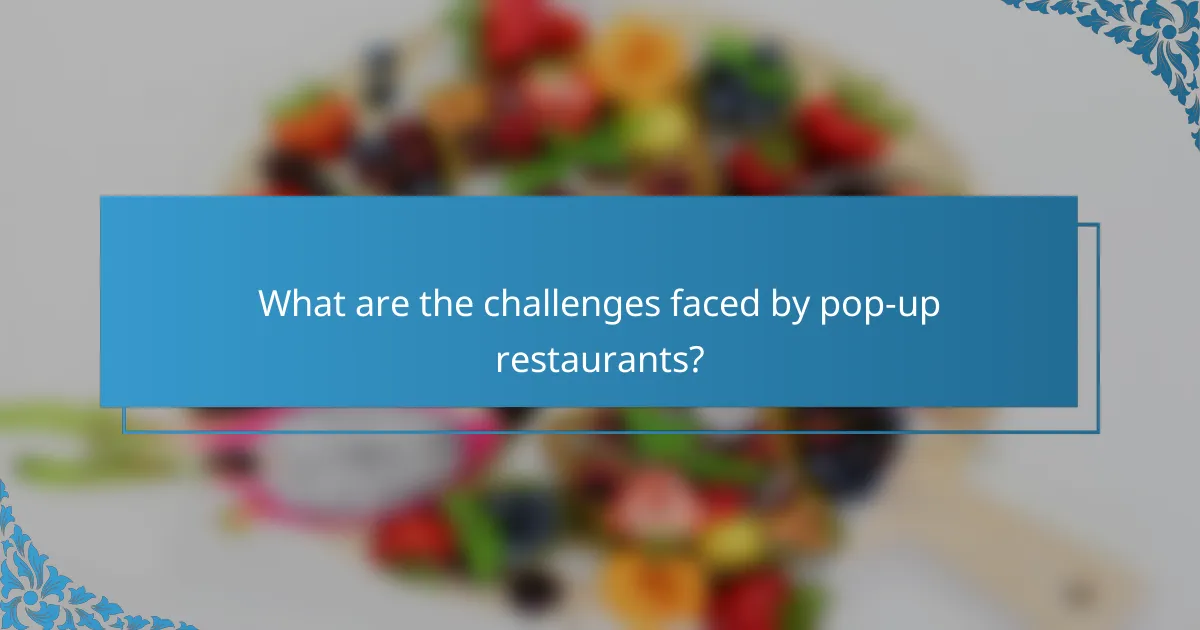
What are the challenges faced by pop-up restaurants?
Pop-up restaurants encounter several challenges that can impact their success, including logistical issues, regulatory compliance, and customer engagement. These obstacles require careful planning and adaptability to create unique dining experiences while maintaining operational efficiency.
Logistical issues with temporary locations
Temporary locations for pop-up restaurants often present logistical challenges such as securing permits, managing supply chains, and coordinating staff schedules. These factors can vary significantly based on the location, requiring thorough research and planning to ensure compliance with local regulations.
For instance, a pop-up in a busy urban area may need to navigate strict health codes and zoning laws, which can differ from those in suburban settings. Additionally, sourcing ingredients on short notice can be difficult, especially if the menu features seasonal or specialty items.
To mitigate these logistical issues, pop-up operators should develop a checklist that includes securing necessary permits, establishing reliable supplier relationships, and creating a flexible staffing plan. This proactive approach helps streamline operations and enhances the overall dining experience for customers.
